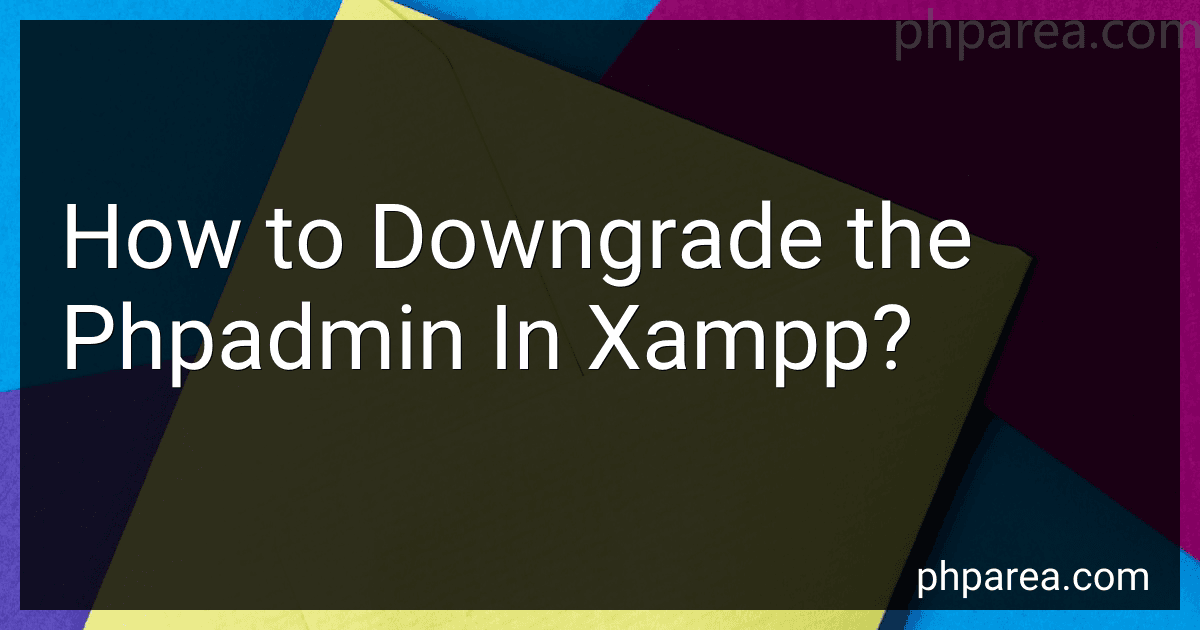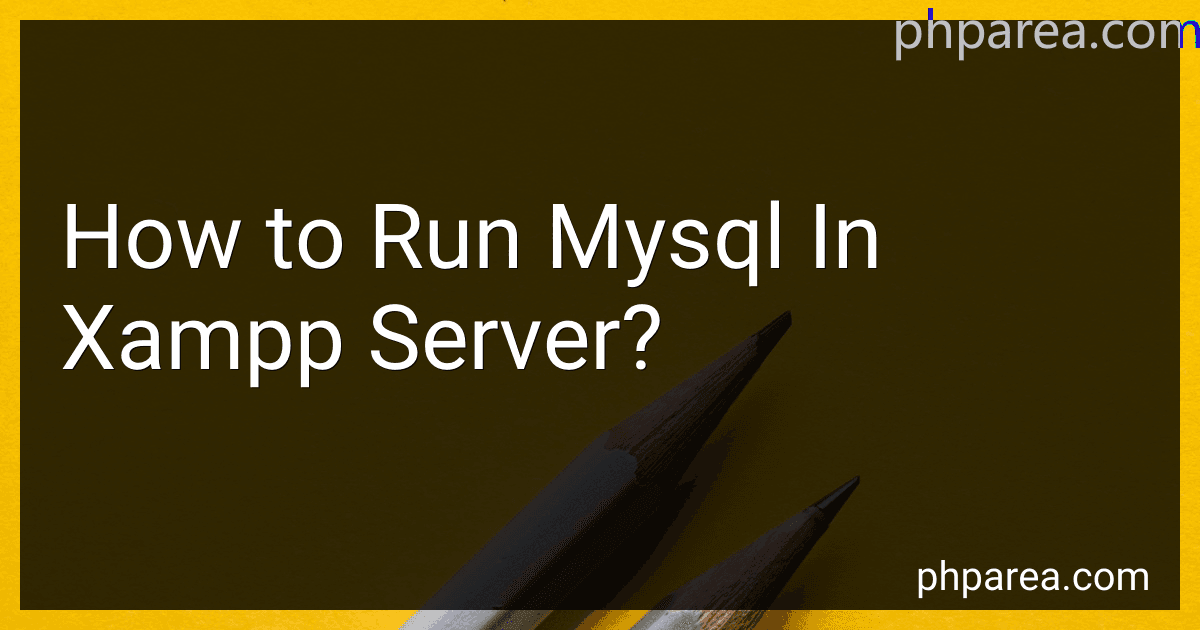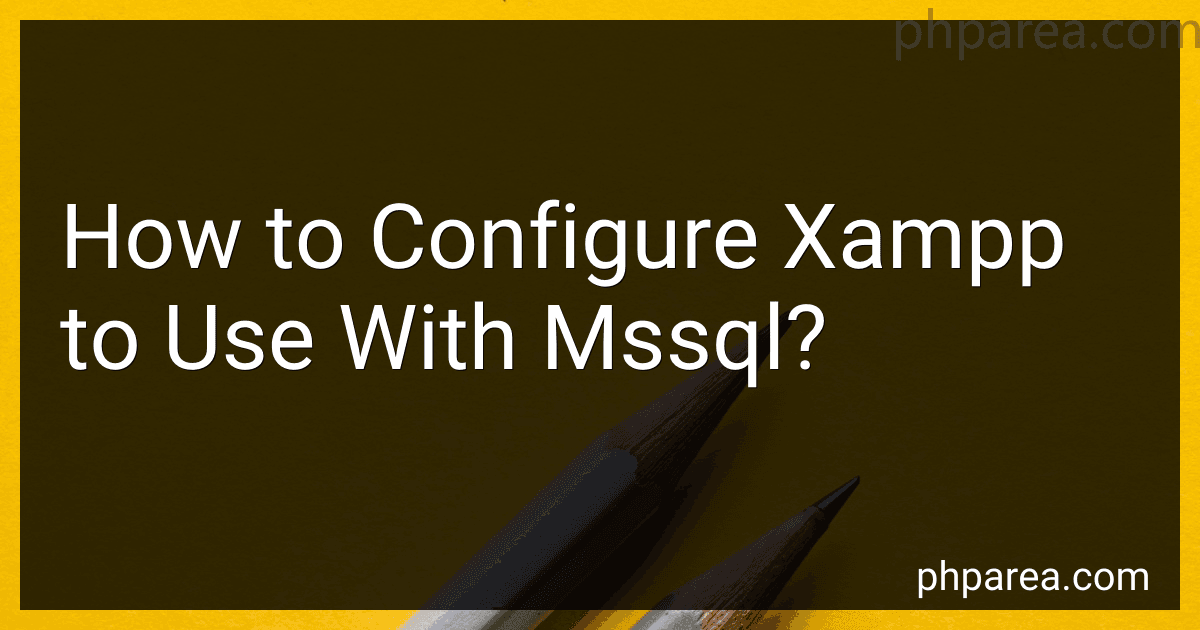PHP Blog
-
 4 min readTo downgrade phpMyAdmin in XAMPP, you will need to first download the older version of phpMyAdmin from the official website. Then, navigate to your XAMPP installation directory and find the phpMyAdmin folder. Replace the existing phpMyAdmin files with the files from the older version you downloaded. Make sure to back up any important data before making these changes. Finally, restart your XAMPP server to apply the changes and verify that the downgrade was successful.
4 min readTo downgrade phpMyAdmin in XAMPP, you will need to first download the older version of phpMyAdmin from the official website. Then, navigate to your XAMPP installation directory and find the phpMyAdmin folder. Replace the existing phpMyAdmin files with the files from the older version you downloaded. Make sure to back up any important data before making these changes. Finally, restart your XAMPP server to apply the changes and verify that the downgrade was successful.
-
 5 min readTo run MySQL in XAMPP server, you first need to start the XAMPP control panel. From there, you can click on the "Start" button next to MySQL to launch the MySQL database server. Once MySQL is running, you can access it through phpMyAdmin, which is a web-based tool that allows you to interact with the MySQL database. You can create databases, tables, run queries, and manage your database content through phpMyAdmin.
5 min readTo run MySQL in XAMPP server, you first need to start the XAMPP control panel. From there, you can click on the "Start" button next to MySQL to launch the MySQL database server. Once MySQL is running, you can access it through phpMyAdmin, which is a web-based tool that allows you to interact with the MySQL database. You can create databases, tables, run queries, and manage your database content through phpMyAdmin.
-
 5 min readTo create a website with XAMPP, first install XAMPP on your computer. XAMPP is a free and open-source cross-platform web server package that includes Apache, MySQL, PHP, and Perl.Once XAMPP is installed, start the Apache and MySQL services in the XAMPP control panel. This will allow you to run a local web server on your computer.Next, create a new folder in the "htdocs" directory of the XAMPP installation. This is where you will store all the files for your website.
5 min readTo create a website with XAMPP, first install XAMPP on your computer. XAMPP is a free and open-source cross-platform web server package that includes Apache, MySQL, PHP, and Perl.Once XAMPP is installed, start the Apache and MySQL services in the XAMPP control panel. This will allow you to run a local web server on your computer.Next, create a new folder in the "htdocs" directory of the XAMPP installation. This is where you will store all the files for your website.
-
 5 min readThere are several alternatives to using memcache for caching in your applications. One popular option is Redis, which is an in-memory data structure store that can be used as a database, cache, and message broker. Redis is known for its speed and flexibility, making it a great choice for caching.Another option is Varnish, a web application accelerator that can also be used as a caching server.
5 min readThere are several alternatives to using memcache for caching in your applications. One popular option is Redis, which is an in-memory data structure store that can be used as a database, cache, and message broker. Redis is known for its speed and flexibility, making it a great choice for caching.Another option is Varnish, a web application accelerator that can also be used as a caching server.
-
 5 min readTo configure XAMPP to use with MSSQL, you first need to download and install the Microsoft Drivers for PHP for SQL Server. After installing the drivers, you need to enable the SQLSRV extension in the PHP configuration file (php.ini) by uncommenting the line extension=sqlsrv.so.Next, you need to specify the server name, user name, password, and database name in the connection string in your PHP code.
5 min readTo configure XAMPP to use with MSSQL, you first need to download and install the Microsoft Drivers for PHP for SQL Server. After installing the drivers, you need to enable the SQLSRV extension in the PHP configuration file (php.ini) by uncommenting the line extension=sqlsrv.so.Next, you need to specify the server name, user name, password, and database name in the connection string in your PHP code.
-
 4 min readTo store complex data structures in memcache, you can serialize the data structure before storing it and deserialize it after retrieving it from the cache.One common method is to serialize the data structure into JSON format using a library such as json in Python or Gson in Java. This allows you to convert complex data structures, such as lists, dictionaries, or objects, into a string that can be stored in memcache.
4 min readTo store complex data structures in memcache, you can serialize the data structure before storing it and deserialize it after retrieving it from the cache.One common method is to serialize the data structure into JSON format using a library such as json in Python or Gson in Java. This allows you to convert complex data structures, such as lists, dictionaries, or objects, into a string that can be stored in memcache.
-
 5 min readTo install PHPUnit with XAMPP using Composer, you first need to make sure that Composer is installed on your system. Then, you can run the following command in your terminal to install PHPUnit: composer require --dev phpunit/phpunit This command will download PHPUnit and its dependencies into your project's vendor directory. After the installation is complete, you can run PHPUnit tests from the command line using the phpunit command.
5 min readTo install PHPUnit with XAMPP using Composer, you first need to make sure that Composer is installed on your system. Then, you can run the following command in your terminal to install PHPUnit: composer require --dev phpunit/phpunit This command will download PHPUnit and its dependencies into your project's vendor directory. After the installation is complete, you can run PHPUnit tests from the command line using the phpunit command.
-
 4 min readMemcache stores data in key-value pairs. When a piece of data is stored in memcache, it is given a unique key that is used to retrieve the data later. The data is stored in the server's memory, which allows for faster access times compared to traditional storage methods like disk-based databases.When a client wants to store data in memcache, it sends a request to the memcache server with the key-value pair.
4 min readMemcache stores data in key-value pairs. When a piece of data is stored in memcache, it is given a unique key that is used to retrieve the data later. The data is stored in the server's memory, which allows for faster access times compared to traditional storage methods like disk-based databases.When a client wants to store data in memcache, it sends a request to the memcache server with the key-value pair.
-
 5 min readTo migrate from XAMPP to WAMP, you would need to follow these steps:Backup your databases and website files from XAMPP.Install WAMP on your system.Copy the website files and databases to the respective directories in WAMP.Update the configuration files in WAMP to match the settings from XAMPP.Test your website to ensure that everything is working correctly in WAMP.Once you have verified that the migration was successful, you can uninstall XAMPP from your system.
5 min readTo migrate from XAMPP to WAMP, you would need to follow these steps:Backup your databases and website files from XAMPP.Install WAMP on your system.Copy the website files and databases to the respective directories in WAMP.Update the configuration files in WAMP to match the settings from XAMPP.Test your website to ensure that everything is working correctly in WAMP.Once you have verified that the migration was successful, you can uninstall XAMPP from your system.
-
 6 min readTo use memcache with PHP, you need to first install the memcached extension for your PHP installation. This extension provides a connection to a memcached server, which allows you to store data in memory for quick access.Once the extension is installed, you can start using memcache in your PHP code by creating a new Memcached object and connecting it to a memcached server. You can then use the set() and get() functions to store and retrieve data from the memcached server.
6 min readTo use memcache with PHP, you need to first install the memcached extension for your PHP installation. This extension provides a connection to a memcached server, which allows you to store data in memory for quick access.Once the extension is installed, you can start using memcache in your PHP code by creating a new Memcached object and connecting it to a memcached server. You can then use the set() and get() functions to store and retrieve data from the memcached server.
-
 5 min readTo change the default htdocs directory in XAMPP, you can follow these steps:Open the XAMPP control panel and stop all the services (Apache, MySQL, etc.).Navigate to the XAMPP installation directory on your system.Locate the "httpd.conf" file in the "apache" folder within the XAMPP directory.Open the "httpd.conf" file using a text editor.
5 min readTo change the default htdocs directory in XAMPP, you can follow these steps:Open the XAMPP control panel and stop all the services (Apache, MySQL, etc.).Navigate to the XAMPP installation directory on your system.Locate the "httpd.conf" file in the "apache" folder within the XAMPP directory.Open the "httpd.conf" file using a text editor.